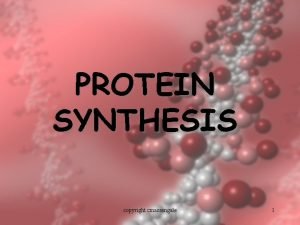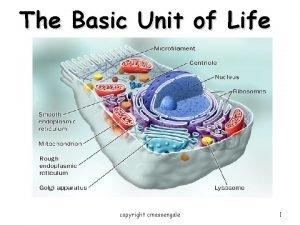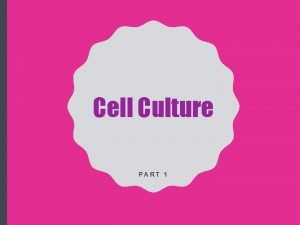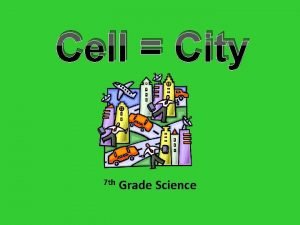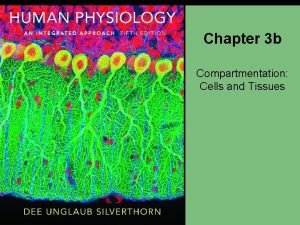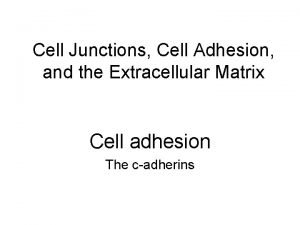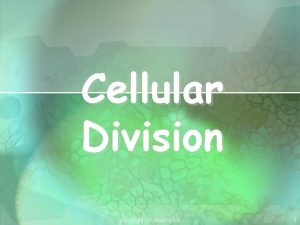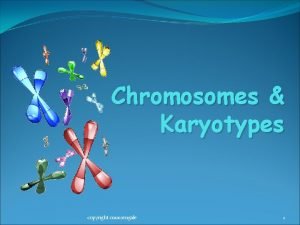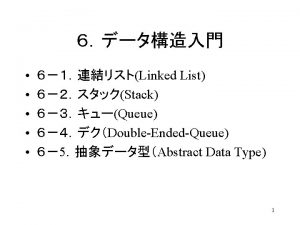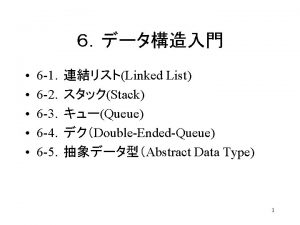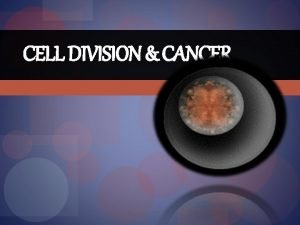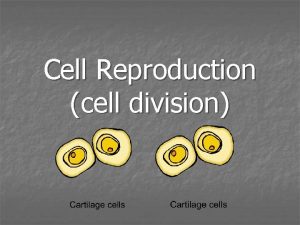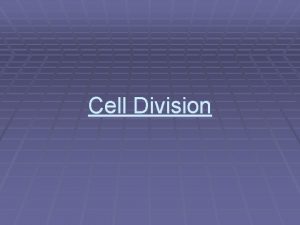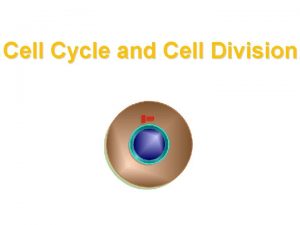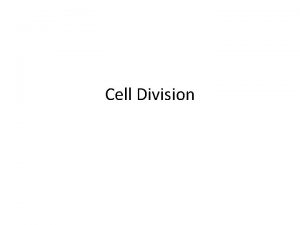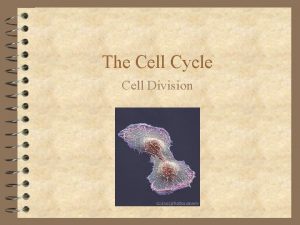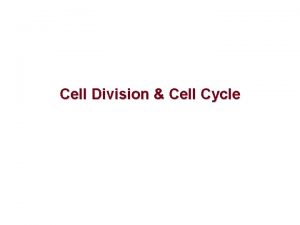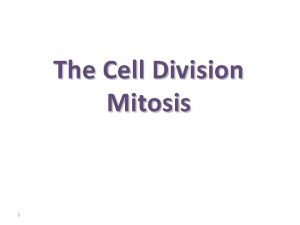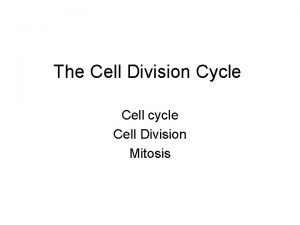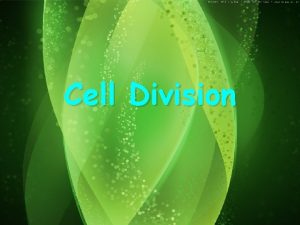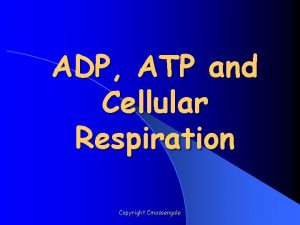Cellular Division copyright cmassengale 1 Cell Division New








































- Slides: 40

Cellular Division copyright cmassengale 1

Cell Division üNew cells are produced for growth and to replace damaged or old cells üDiffers in prokaryotes (bacteria) and eukaryotes (protists, fungi, plants, & animals) copyright cmassengale 2

Keeping Cells Identical The instructions for making cell parts are encoded in the DNA, each new cell must get a complete set of the DNA molecules copyright cmassengale 3

DNA Replication üDNA must be Original DNA copied before strand cell division üEach new cell has an identical Two new, identical DNA copy of the DNA strands copyright cmassengale 4

Identical Daughter Cells Two identical daughter cells Parent Cell copyright cmassengale 5

Chromosomes copyright cmassengale 6

Eukaryotic Chromosomes üAll eukaryotic information in cells store genetic chromosomes ü Human body cells have 46 chromosomes or 23 identical pairs copyright cmassengale 7

Eukaryotic Chromosomes üChromosome is composed of a single, tightly coiled DNA molecule üChromosomes can’t be seen when cells aren’t dividing and are called chromatin copyright cmassengale 8

Compacting DNA into Chromosomes üDNA is tightly coiled around proteins called histones copyright cmassengale 9

Chromosomes in Dividing Cells üDuplicated chromosomes are called chromatids & are held together by the centromere Called Sister Chromatids copyright cmassengale 10

Boy or Girl? The Y Chromosome Decides Y - Chromosome X - Chromosome copyright cmassengale 11

Diploid & Haploid • Diploid cells - having 2 sets of chromosomes. Represented by 2 n. • All normal cells are diploid cells. • Human body cells (Somatic) copyright cmassengale 12

Haploid • Cells containing one set of chromosome • Sperm & egg cell. • Half the number of chromosomes. Represented by 1 n • When sperm & egg combine create first diploid cell. copyright cmassengale 13

Cell Reproduction copyright cmassengale 14

Types of Cell Reproduction üAsexual reproduction involves a single cell dividing to make 2 new, identical daughter cells üMitosis an example of asexual reproduction üSexual reproduction involves two cells (egg & sperm) that is NOT identical to the original cells üMeiosis is an example copyright cmassengale 15

The Cell Cycle copyright cmassengale 16

Five Phases of the Cell Cycle üG 1 - primary growth phase üS – synthesis; DNA replicated üG 2 - secondary growth phase collectively these 3 stages are called interphase üM - mitosis üC - cytokinesis copyright cmassengale 17

Cell Cycle DNA Copied Cells prepare for Division Cells Mature Daughter Cells Cell Divides into Identical cells copyright cmassengale 18

Interphase - G 1 Stage ü 1 st growth stage after cell division üCells mature by making more cytoplasm & organelles üCell carries on its normal metabolic activities copyright cmassengale 19

Interphase – S Stage üSynthesis stage üDNA is copied or replicated Two identical copies of DNA Original DNA copyright cmassengale 20

Interphase – G 2 Stage ü 2 nd Growth Stage üOccurs after DNA has been copied üAll cell structures needed for division are made (e. g. centrioles) üBoth organelles & proteins are synthesized copyright cmassengale 21

Mitosis copyright cmassengale 22

Mitosis üDivision of the nucleus üOnly occurs in eukaryotes üHas four stages üDoesn’t occur in some cells such as brain cells copyright cmassengale 23

Four Mitotic Stages üProphase üMetaphase üAnaphase üTelophase copyright cmassengale 24

Prophase üChromatin in condenses to form visible chromosomes üSpindle fibers form from fibers in centrioles (animal) Cytoplasm Nucleolus Nuclear Membrane Chromosomes copyright cmassengale 25

Prophase üNuclear membrane & nucleolus are broken down üChromosomes continue condensing üSpindle fibers attach to the centromere and finish forming between poles copyright cmassengale 26

Prophase Chromosomes Nucleus & Nucleolus have disintegrated copyright cmassengale 27

Spindle Fiber attached to Chromosome Spindle fiber Chromosome copyright cmassengale 28

Metaphase copyright cmassengale 29

Metaphase üChromosomes move to the center of the cell üChromosomes are now lined up at the equator Equator of Cell Pole of the Cell copyright cmassengale 30

Metaphase Spindle Fibers copyright cmassengale Chromosomes lined at the Equator 31

Metaphase Chromosomes at Equator copyright cmassengale 32

Anaphase üOccurs rapidly üSister chromatids are pulled apart to opposite poles copyright cmassengale 33

Anaphase Sister Chromatids being separated copyright cmassengale 34

Telophase üSister chromatids at opposite poles üSpindle disassembles üNuclear envelope forms around each set of sister chromatids üNucleolus reappears üCYTOKINESIS occurs üChromosomes reappear as chromatin copyright cmassengale 35

Cytokinesis üMeans division of the cytoplasm üDivision of cell into two, identical halves called daughter cells üIn plant cells, cell plate forms üIn animal cells, cleavage furrow copyright cmassengale 36

Cytokinesis Cleavage furrow in animal cell Cell plate in plant cell copyright cmassengale 37

Mitotic Stages copyright cmassengale 38

Daughter Cells of Mitosis üHave the same number of chromosomes as each other and as the parent cell üIdentical to each other, but smaller than parent cell üMust grow in size to become mature cells (G 1 of Interphase) copyright cmassengale 39

Identical Daughter Cells What is the 2 n or diploid number? 2 Chromosome number the same, but cells smaller than parent cell copyright cmassengale 40
 Cmassengale
Cmassengale Cmassengale
Cmassengale Cmassengale
Cmassengale Cell cycle and cell division
Cell cycle and cell division Cell cycle and cell division
Cell cycle and cell division Cell cycle and cell division
Cell cycle and cell division Cellular transport and the cell cycle
Cellular transport and the cell cycle All cells must contain
All cells must contain Where in the cell does cellular respiration occur
Where in the cell does cellular respiration occur Where in the cell does cellular respiration occur
Where in the cell does cellular respiration occur Cell city worksheet
Cell city worksheet Denuding tower
Denuding tower Prokaryotic cell vs eukaryotic cell
Prokaryotic cell vs eukaryotic cell Prokaryotic and eukaryotic cells
Prokaryotic and eukaryotic cells Venn diagram of organelles in plant and animal cells
Venn diagram of organelles in plant and animal cells S
S Dry cell vs wet cell
Dry cell vs wet cell Venn diagram animal and plant cells
Venn diagram animal and plant cells Function of cells
Function of cells Tonoplast
Tonoplast Vacuole function
Vacuole function Cell wall cell membrane
Cell wall cell membrane Cell strain
Cell strain Finite and continuous cell lines
Finite and continuous cell lines Cell city project
Cell city project Primary voltaic cell
Primary voltaic cell Difference between plant and animal cell
Difference between plant and animal cell Cell-cell junction
Cell-cell junction Cell-cell junction
Cell-cell junction Which organelle prepares proteins for specific jobs
Which organelle prepares proteins for specific jobs Prokaryotic cell and eukaryotic cell
Prokaryotic cell and eukaryotic cell Carbohydrate side chain
Carbohydrate side chain Chapter 4 cell theory and cell study
Chapter 4 cell theory and cell study Cell organelles graphic organizer
Cell organelles graphic organizer Idealized plant cell
Idealized plant cell Walker cell and hadley cell
Walker cell and hadley cell Eukaryotic vs prokaryotic cells
Eukaryotic vs prokaryotic cells Biology.arizona.edu/cell bio/activities/cell cycle/01.html
Biology.arizona.edu/cell bio/activities/cell cycle/01.html Matlab string builder
Matlab string builder Galvanic vs electrolytic cell
Galvanic vs electrolytic cell What is the gooey liquid in plant and animal cells
What is the gooey liquid in plant and animal cells
